
Cedar Falls is a city in Black Hawk County, Iowa, United States. As of the 2020 census, the city population was 40,713. Cedar Falls is home to the University of Northern Iowa, a public university.

Waterloo is a city in and the county seat of Black Hawk County, Iowa, United States. As of the 2020 United States Census the population was 67,314, making it the eighth-most populous city in the state.
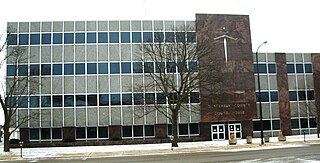
Black Hawk County is a county in the northeastern part of U.S. state of Iowa. As of the 2020 census, the population was 131,144, making it Iowa's fifth-most populous county. The county seat is Waterloo.
Grand Army of the Republic Hall, GAR Building, or variants thereof, may refer to:

The Grand Army of the Republic Hall is an historic building located at 23 East Downer Place on Stolp Island in Aurora, Illinois, in the United States.
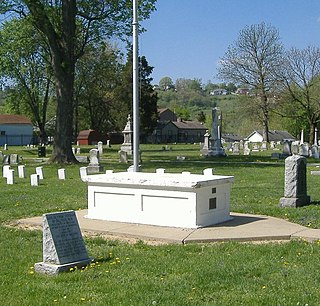
The Grand Army of the Republic Monument, in the Linden Grove Cemetery of Covington, Kentucky, was built in 1929 by the O. P. Sine of Garfield Post No. 2 of the Grand Army of the Republic, a group comprising the remaining veterans of the Union army.

The Franklin County G. A. R. Soldiers' Memorial Hall, also known simply as the Soldiers' Memorial Hall, is a historic building located in Hampton, Iowa, United States. The octagonal-style structure was designed and built in 1890 by Edward Carl Keifer. It was the meeting place of the J.W. McKenzie Post No. 81, Grand Army of the Republic (G.A.R.), which was one of 519 GAR posts in Iowa. The building is architecturally significant as it is one of the few examples of a Gothic Revival style structure of this type in the area. It is a memorial chapel that follows a cross-shaped plan capped by an octagonal cupola with a statue of a Union soldier on top. Its significance is also derived from it being the first G.A.R. Memorial Hall built in Iowa. The Iowa legislature had passed a law in 1884 that allowed counties to levy a tax to support building G.A.R. memorials. Captain Rufus S. Benson, a local state representative, had the law amended in 1886 so that it allowed for the construction of a memorial hall, as the local G.A.R. chapter wanted it to be a place where they could meet.

Here is presented a listing of the National Register of Historic Places in Black Hawk County, Iowa.
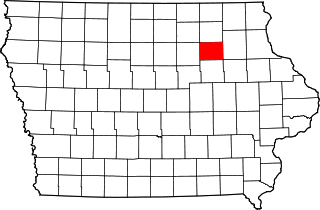
This is a list of the National Register of Historic Places listings in Bremer County, Iowa.

The Veteran's Memorial Building is located on May's Island in the middle of the Cedar River in Cedar Rapids, Iowa, United States. It is a contributing property to the May's Island Historic District that was listed on the National Register of Historic Places in 1978. The building served as the Cedar Rapids City Hall until it was damaged in the Flood of 2008. The Building underwent a ribbon-cutting ceremony to mark its official re-opening April 15, 2014.
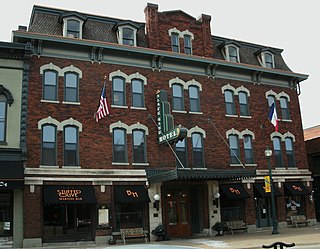
The Black Hawk Hotel is an historic building located in downtown Cedar Falls, Iowa, United States. It was individually listed on the National Register of Historic Places in 2002. In 2017 it was included as a contributing property in the Cedar Falls Downtown Historic District.

The Stephenson Grand Army of the Republic Memorial, also known as Dr. Benjamin F. Stephenson, is a public artwork in Washington, D.C. honoring Dr. Benjamin F. Stephenson, founder of the Grand Army of the Republic, a fraternal organization for Union veterans. The memorial is sited at Indiana Plaza, located at the intersection of 7th Street, Indiana Avenue, and Pennsylvania Avenue NW in the Penn Quarter neighborhood. The bronze figures were sculpted by J. Massey Rhind, a prominent 20th-century artist. Attendees at the 1909 dedication ceremony included President William Howard Taft, Senator William Warner, and hundreds of Union veterans.

The Cedar Falls Historical Society is located in Cedar Falls, Iowa. It strives to preserve the history of Cedar Falls, Black Hawk County and Iowa through its collection and five museums. It is also involved with community outreach, garden tours, guided tours, and research.

Sac City Monument Square Historic District is a nationally recognized historic district located in Sac City, Iowa, United States. It was listed on the National Register of Historic Places in 2015. The square consists of the General Sherman Hall (1892), Memorial Statue (1894), the American Legion Hall (1922), four World War II era Howitzers, and three granite tablets that commemorate the lives of the soldiers from Sac County who fought in World War I, World War II, the Korean War, and the Vietnam War. The Vietnam War tablet does not contribute to the historic district because it is a more recent installation.

John G. Ralston was an American architect who worked out of Waterloo, Iowa. A number of his works are listed on the U.S. National Register of Historic Places for their architecture.
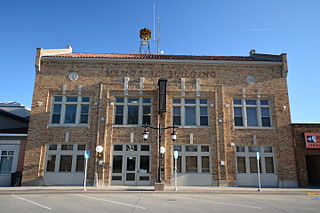
Memorial Building, also known as Dyersville City Hall, is a historic building located in Dyersville, Iowa, United States. When this structure was completed in 1929 it housed the following functions: police department, fire department, municipal offices, post office, library, community hall, and gymnasium. It replaced the 1893 city hall at the same location that housed all those functions except the library and gymnasium. Its function as a veteran's memorial was overseen by the American Legion, which also was initially located here. The Legion, fire station and post office have subsequently relocated to other facilities. The previous city hall had been damaged in a fire in 1928. The Waterloo, Iowa architectural firm of Ralston and Ralston designed the two-story brick Colonial Revival style building to replace it. Raymond Klass of Louisburg, Wisconsin was the contractor who built the new structure. The building was completed on December 12, 1929, for just over $40,000. It was listed on the National Register of Historic Places in 2013.

The Cedar Falls Historic District is a nationally recognized historic district located in Cedar Falls, Iowa, United States. It was listed on the National Register of Historic Places in 2017. It is made up of 59 buildings that were constructed between 1860 and 1960. Of those, 46 were determined to be significantly historic. Four of the buildings were individually listed on the National Register of Historic Places in previous years; they include the Black Hawk Hotel (1870), the Odd Fellows Temple (1902), and the Oster Regent Theater (1910).

The Waterloo East Commercial Historic District is a nationally recognized historic district located in Waterloo, Iowa, United States. It was listed on the National Register of Historic Places in 2011. At the time of its nomination the district consisted of 36 resources, including 28 contributing buildings, and eight non-contributing buildings. The city of Waterloo was established in the early 1850s. Its first settlers started developing the west side of the city before crossing the Cedar River and developing east side. The first Black Hawk County Courthouse was built on the east side in 1856 and East Waterloo Township was created two years later. As industry began to develop along the river, and the arrival of the first railroad in 1861, the commercial district on the east side began to grow. Also on the east side of town was the terminus of the streetcar-turned-interurban system. By 1900, the city became one of the primary wholesale and retail centers in northeastern Iowa. In 1911 the Black population increased significantly as workers, primarily from Mississippi, moved into town to work for the Illinois Central Railroad. The following year the saloons in town were closed and bootlegging, gambling, drugs, and prostitution started to increase in the area surrounding the central business district. All of these developed put together created the atmosphere of the downtown commercial district.




















